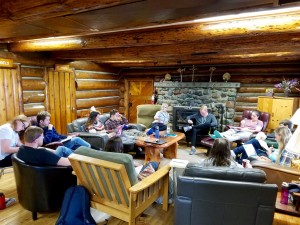“You can’t depend on your eyes when your imagination is out of focus.”
– Mark Twain
Swarm of young spawn at Macaulay Salmon Hatchery
Sonia and Cecilia
When Sonia checked the weather of Juneau days before leaving State College, she knew what to anticipate rain on the trip. Sonia was warned about Alaskan rain; however, one doesn’t understand Alaskan weather until experiencing it firsthand. When it rains here, it really rains (all day, no stop). So, as the rain drops fell and fell outside the lodge window, Sonia believed everyone would have the chance to have a relaxing day. (A note to blog readers: a slow day in the CAUSE life does not actually mean a free day. It’s more like a break from our usual six plus mile hikes.)
Aside from giving our knees and ankles a much needed rest, today provided us with our first chance to reflect on our arrival to Alaska. Sometimes on study abroad trips such as this, days packed with hikes and culturally immersive activities cause people to forget to take a moment and breathe. Today was our day to really soak in Alaska and acknowledge how truly amazing it is to be here.
Mike began the day by asking us all to take out our journals and write down our experiences since arriving in Alaska. We could write about whatever we wanted, pretty cool right? How often in a college course do you get the chance to choose your journal topic, whether it be feelings, science, events or all of the above? For those of you who do not know, the answer is basically never. So we sat in a circle and journaled together. Thirty minutes dedicated to silence and our thoughts.
CAUSE students diligently journalling back at the lodge.
As Sonia began to write, she realized just how long it has been since she allowed herself to open up on paper. She wrote for pages, rambling on and on about how excited she was to have a break from my work schedule and be in Alaska. Half way through the journaling experience, she began to get distracted by the nature right outside the living room window. The log cabin we are staying in is beautifully situated on the seaside. As Sonia looked at the scene outside, with zoned out admiration, she picked up her pen again and began to draw the landscape that she saw. For a good couple minutes, she sketched all of the trees that were close to the window, and then began drawing the outline of the water. By taking my time to outline the individual pine needles, then the branches, then the trees, it really allowed Sonia to recognize the reason she joined this program. Essentially, CAUSE is set up to look at separate ecosystems as part of a larger cycle. While we are only sampling from certain wetlands in both Peru and Alaska, we are using the individual sites in both hemispheres to represent ecological changes around the world. It is the individual pine needles of a whole tree that we study. So as she looked out the window, into the beautiful scenery, Sonia truly felt the magnitude of how much it matters to take both a closer look and to also recognize that we are all part of a larger system. There is still have plenty to learn, but today Sonia felt a brief moment of understanding. She hopes her newfound epiphany can carry her through the next school year, too.
Later in the day we toured the Macaulay Salmon Hatchery. This was an interesting business set-up because of how they used an understanding of the lifecycle of the salmon to most effectively harvest them. Walking into the fishery, salmon were clamoring up sloped pools to return to spawn. Andy taking in the scene said, “This is so depressing; they are queuing to die.” Although the fishes’ journey would ultimately end with their slaughter, this would occur in the natural world anyway. Salmon complete their lifecycle with swimming a treacherous trek upstream getting picked off as each interval by many predators. After they reach their gravelly spawning grounds, they stick around for a few weeks to protect their young until their broken and exhausted bodies succumb to death. The migration of the salmon represents nutrients returning from the ocean to the river systems. The fisheries utilize the natural lifecycle of the fish while employing thousands of Alaskans. Fish born at the fishery have a 2-4% survival rate, while wild salmon have a .5% survival rate.
Our tour of the Macaulay Salmon Hatchery
We asked our guide how increasing water temperatures might affect the salmon migration. For now, the increased temperatures have made the conditions more ideal for salmon, but further increased temperatures could make the waters unsuitable for salmon. This Is especially true when considering how the receding glacier buffers the temperature of the water and once the glaciers are gone the waters will heat up even more.



